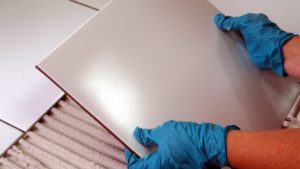
How to stop water leaking through bathroom and shower tiles
Leaky tiles can occur anywhere where water is used, whether it’s a shower, a wet room or a kitchen splashback. They can often cause damp and mould within surfaces behind tiles, and can even threaten the structural integrity of walls, so it’s important to tackle the issue at the first sign of a leak.
Water getting behind tiles can also damage the tile adhesive, which could cause tiles to come loose, and possibly fall off the wall altogether.
In this handy guide, Saint-Gobain Weber will walk through how to replace grout and silicone which will seal the tiles without having to remove them. If there is a serious leak however, the tiles will have to be removed and a new waterproofing system will have to be installed before putting them back.

Replace grout
If the grout is visibly cracked or crumbling, it’s likely going to be letting water behind the tiles. Even if the grout doesn’t appear to be damaged, if it’s not water-resistant it could potentially be the source of the leak. Either way, it’s probably a good idea to remove and replace – particularly any grout that is visibly damaged.
Grout can be removed by hand, either using a manual grout removal tool or power tool with an oscillating action, both of which are widely available from hardware stores. To ensure the tiles don’t get damaged, it’s a good idea to tape off the grout lines before beginning the removal process.
Before applying new grout, ensure tiles are firmly adhered and that the gaps in between are clean. A squeegee or rubber float can then be used to apply water-resistant grout in small sections. Ensure a smooth, even finish is created with no gaps which could cause further problems down the line.
Remove excess grout from tile surfaces as soon as possible, and then leave to dry for around half an hour. Finally, a damp emulsifying pad or sponge can be used to clean any remaining grout residue from the tile surface.
weberjoint premium grout is not only water-resistant and mould-resistant but has been formulated with PURE CLEAN anti-stain technology, so is ideal for any re-grouting. It’s available in 18 colours which are colour matched to the silicone sealant, so there’s plenty of choice when it comes to the finish.
Replace silicone
Water can also seep around the edges of tiled areas. To prevent this from happening, a silicone sealant should be used to seal the joints between tiles and other surfaces such as windows, sinks and walls at the edges of splashbacks.
If the silicone seal has been broken, this should be removed before applying new sealant. This can be done using a sharp knife or chisel, ensuring all appropriate safety measures are taken. Take extra care not to damage the tiles when removing the silicone.
As with grout, it’s important to ensure the chosen silicone is mould and fungus resistant if it’s intended for use in wet areas. Surfaces must be clean and dry before sealant is applied into joints, using a spatula to smooth it in. Finish by cleaning off any excess before it cures.
weberjoint silicone is Saint-Gobain Weber’s sealant which will cure to form a tough, watertight seal. It’s available as a clear sealant as well as in the 18 colours of our premium grout, so it’s ideal for finishing the job.
Remove and replace tiles
As a last resort, the tiles may need to be removed in order to fix any leaks. To give the walls (and the tiles) the correct protection, it’s a good idea to use an under tile tanking kit, which is a waterproofing system specifically designed for use in bathrooms and wet rooms.
Apply the tanking paint with a roller, covering the area to protect surfaces in wet areas. This will help to prevent water damage to surfaces in case of a leak or future damage to grout and sealant.
webersys protect is Saint-Gobain Weber’s ready-mixed tanking kit which is ideal for waterproofing your shower or bathroom. It comes as a kit with everything needed to protect the walls from water – primer, tanking paint and tanking tape.
For more tiling advice, visit Saint-Gobain Weber’s website.




